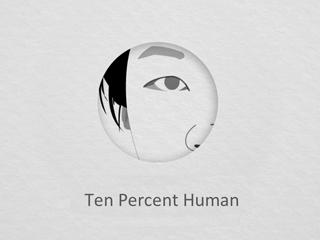Ten Percent Human
Yoonjo Choi
A web-based creative visualization which delivers information about quantity and diversity of human microbiomes.
tenpercenthuman.herokuapp.com

"Ten Percent Human" is a web-based creative visualization which delivers information about quantity and diversity of human microbiomes. My own are identified through extensive lab research, and will be shown on the site as an abstract representation.
Background
1. Investigation
- TED Talk
Bonnie Bassler: How bacteria "talk"
- Wet Lab: Swab my skin and grow the bacteria in petri dishes to see how bacteria look and investigate how it grows.
2. Interview with Experts:
Dr. Murry Orbuck, M.D.
- NYU Student Health Center (Gastroenterology)
- Permission for a 'Gastronintestinal Tract Bacteria Test' from Metametrix. (Decided not to proceed, due to insurance coverings.)
Martin J. Blaser, M.D.
- NYU, Department of Medicine, Professor of Microbiology
- Information about Research papers.
ex. [The Skin Microbiome] Elizabeth A. Grice, Julia A. Segre
[Bacterial Community Variation in Human Body Habitats Across Space and Time]
3. Genspace
- Attended 'Bio Crash Course' class, covering PCR (Polymerase Chain Reaction) methods.
- Help with finding the right primers from research papers to identify my own bacteria.
- [Potential for Mercury Reduction by Microbes in the High Arctic]:
forward primer 27F (5 -AGAGTTTGATCMTGGCTCAG-3 )
reverse primer 907R (5 -CCGTCAATTCATTTGAG-3 )
4. Technology
- Weg GL, three.js
Audience
Anyone who is interested in Human Microbiomes and Data Visualization.
User Scenario
The website starts with a graphic of my face. As the user scrolls down, the image enlarges, as if you are going into a micro level. After that, four tabs appear: Quantity, Size, Diversity and Geography. The user is able to navigate through each tab and explore and learn through the interactive data visualizations.
Implementation
"Ten Percent Human" is a web-based creative visualization using Web GL, Three.js and D3. The amount and percentage of each bacteria that populates on our skin is represented in the four visuals. The user may navigate within tabs and learn more about the bacteria that consists us.
Conclusion
During my thesis research process, I discovered that humans share a great amount of bacteria with each other and the bacterial culture that lives with us differs greatly due to lifestyle and geo-location. Prior to my thesis, I had thought I would have a very unique set of bacteria that distinguishes me from others, but that was not the case. Additionally, I learned that not all bacteria are bad. We all have good and bad bacteria, but it is the matter of having a good balance between the two to maintain healthy.
Overall, my thesis inspiration had started with the fascination of the amount of bacteria we humans hold. During the process, I found it even more fascinating that we share a great amount of bacteria with those next to us. This helped me see my surroundings in a different perspective: how similar and different we are from each other. My hopes are that this project will inspire others into seeing their surroundings differently and learn more about the bacteria that live with them at all times.
Background
1. Investigation
- TED Talk
Bonnie Bassler: How bacteria "talk"
- Wet Lab: Swab my skin and grow the bacteria in petri dishes to see how bacteria look and investigate how it grows.
2. Interview with Experts:
Dr. Murry Orbuck, M.D.
- NYU Student Health Center (Gastroenterology)
- Permission for a 'Gastronintestinal Tract Bacteria Test' from Metametrix. (Decided not to proceed, due to insurance coverings.)
Martin J. Blaser, M.D.
- NYU, Department of Medicine, Professor of Microbiology
- Information about Research papers.
ex. [The Skin Microbiome] Elizabeth A. Grice, Julia A. Segre
[Bacterial Community Variation in Human Body Habitats Across Space and Time]
3. Genspace
- Attended 'Bio Crash Course' class, covering PCR (Polymerase Chain Reaction) methods.
- Help with finding the right primers from research papers to identify my own bacteria.
- [Potential for Mercury Reduction by Microbes in the High Arctic]:
forward primer 27F (5 -AGAGTTTGATCMTGGCTCAG-3 )
reverse primer 907R (5 -CCGTCAATTCATTTGAG-3 )
4. Technology
- Weg GL, three.js
Audience
Anyone who is interested in Human Microbiomes and Data Visualization.
User Scenario
The website starts with a graphic of my face. As the user scrolls down, the image enlarges, as if you are going into a micro level. After that, four tabs appear: Quantity, Size, Diversity and Geography. The user is able to navigate through each tab and explore and learn through the interactive data visualizations.
Implementation
"Ten Percent Human" is a web-based creative visualization using Web GL, Three.js and D3. The amount and percentage of each bacteria that populates on our skin is represented in the four visuals. The user may navigate within tabs and learn more about the bacteria that consists us.
Conclusion
During my thesis research process, I discovered that humans share a great amount of bacteria with each other and the bacterial culture that lives with us differs greatly due to lifestyle and geo-location. Prior to my thesis, I had thought I would have a very unique set of bacteria that distinguishes me from others, but that was not the case. Additionally, I learned that not all bacteria are bad. We all have good and bad bacteria, but it is the matter of having a good balance between the two to maintain healthy.
Overall, my thesis inspiration had started with the fascination of the amount of bacteria we humans hold. During the process, I found it even more fascinating that we share a great amount of bacteria with those next to us. This helped me see my surroundings in a different perspective: how similar and different we are from each other. My hopes are that this project will inspire others into seeing their surroundings differently and learn more about the bacteria that live with them at all times.


